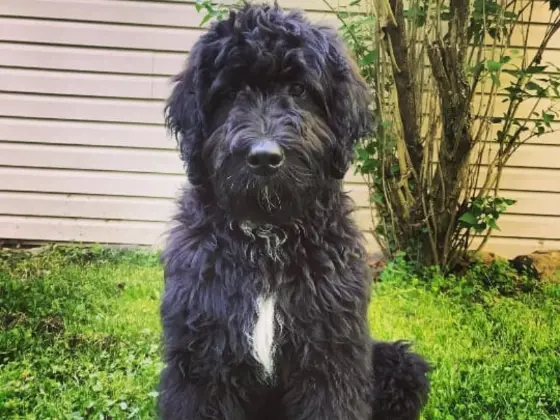Advanced Training Techniques for Bernedoodles as Service or Therapy Dogs
Bernedoodles are a remarkable blend of the intelligent Poodle and the loyal Bernese Mountain Dog. They’re gentle, affectionate, and quick learners—traits that make them ideal candidates for therapy or service work. But to truly harness their potential, you need more than basic obedience training. You need structured, advanced techniques tailored to their emotional and cognitive abilities.
This guide dives deep into practical and compassionate training methods to help your Bernedoodle succeed in the real world—whether it’s calming an anxious child, assisting with physical tasks, or offering emotional support.
Let’s unlock their full power as reliable, gentle helpers for those who need them most.

1. Understanding the Bernedoodle’s Temperament
Before any training begins, it’s crucial to understand your dog’s natural personality. Bernedoodles tend to be:
- Gentle and patient like the Bernese Mountain Dog parent
- Highly intelligent and eager to please like the Poodle parent
- Emotionally sensitive, meaning they respond well to encouragement but poorly to harsh tones
These dogs naturally crave companionship and thrive when given a purpose. If your Bernedoodle is calm, sociable, and not easily startled, they have the right foundation for therapy or service work.
Tip: Observe your dog in different environments. How do they react to loud noises? Crowds? Sudden movements? Their response will guide how much conditioning they’ll need.
Knowing this helps you build trust, reduce fear-based reactions, and create a safe training environment. Once you establish a solid emotional bond, they’ll mirror your energy, making learning easier and deeper.

2. Evaluating Your Bernedoodle’s Suitability for Service or Therapy Work
Not every Bernedoodle is cut out for this job—and that’s okay. You must assess their ability to handle stress, ignore distractions, and remain calm under pressure.
Start with the Canine Good Citizen (CGC) test. It covers:
- Reaction to strangers
- Walking through crowds
- Sit and stay on command
- Reaction to distractions
- Supervised separation from the owner
Beyond that, therapy dogs should enjoy being touched, hugged, or petted by strangers without showing discomfort. Service dogs, on the other hand, should show a high task focus, be able to ignore food or attention, and work independently when needed.
Real-Life Tip: Try taking your dog to a pet-friendly store or park and observe how they handle new stimuli. If they remain calm and responsive, you’re on the right track.
If your dog shows anxiety or fear, it doesn’t mean they’re disqualified. With patience and training, many dogs can overcome those behaviors.

3. Building a Strong Obedience Foundation
Service and therapy dogs must have obedience skills that function even under stress or distraction. Start with:
- Sit, Down, Stay, Come, Heel, and Leave it
- Use positive reinforcement (treats, praise, clickers)
- Practice in different settings (home, park, sidewalk, store)
Bernedoodles are sensitive. Avoid yelling or punishment—these tactics can break their trust and set training back. Instead, keep sessions short (10–15 minutes) but frequent. Repeat commands with calm authority, and reward every success, even small ones.
Pro Tip: Use the “3 D’s” of training—Distance, Distraction, and Duration. Increase one at a time when practicing commands.
Consistency is the backbone of obedience. If you skip practice or use unclear cues, your dog gets confused. Make commands and routines as predictable as possible.

4. Desensitization to Environments, Sounds, and Movement
In real-life service situations, your dog might enter hospitals, airports, crowded schools, or public buses. These environments are full of noise, movement, and emotional energy. You must train your Bernedoodle to remain focused and calm.
Start Small:
- Play recorded city sounds or hospital noises at a low volume during training sessions.
- Gradually increase the volume and complexity over time.
- Introduce moving wheelchairs, shopping carts, children running, etc.
Emotional Insight: Dogs absorb your energy. If you remain calm during stressful moments, your dog learns to do the same.
Your goal is to make unusual sounds and settings feel normal. Bernedoodles are naturally curious—help that curiosity grow into confidence.
Exercise: Practice “go to place” on a mat in noisy areas. Reward them for staying on the mat, even if a vacuum or skateboard goes by.
This stage prepares them for calmness in unpredictable places like elevators, events, or therapy sessions.

5. Task-Specific Training for Service Dogs
Bernedoodles can be taught specific service tasks like:
- Opening drawers or doors using rope handles
- Retrieving dropped items like keys or medicine bottles
- Alerting a medical episode by pawing or barking
- Bracing or guiding movement (for mobility support)
Use shaping techniques—break the task into small steps and reward each success. Use consistent verbal cues like “help” or “fetch.”
Real Story Idea: Imagine someone with arthritis struggling to bend down. A trained Bernedoodle picks up the dropped pen and places it gently in their hand. That’s life-changing.
Be patient. These are advanced tasks and can take weeks or months to master. Consistency, praise, and trust are the magic trio.

6. Deep Pressure Therapy (DPT) – Comfort on Command
Many therapy dogs are trained to perform Deep Pressure Therapy (DPT) to help people with anxiety, PTSD, or autism. It involves the dog gently lying across a person’s lap or chest to provide calming pressure.
How to Train:
- Use a command like “snuggle” or “comfort”
- Lure your dog to climb partially on your lap or chest
- When positioned correctly, say the command and give a treat
- Practice increasing duration slowly
Bernedoodles are naturally affectionate, making them perfect for this task. Once trained, DPT can become a valuable tool during meltdowns or emotional episodes.
Bonus Tip: Train DPT while you’re lying on the couch or floor—it mimics real-life scenarios better.
This task is especially useful for veterans, children with sensory needs, or adults with panic attacks.

7. Enhancing Focus & Distraction Control
Public places are full of distractions—dogs, smells, food, noise, people. A well-trained Bernedoodle must stay connected to their handler’s cues.
Use focus exercises daily:
- “Watch me” command: hold a treat to your eyes, say the cue, reward eye contact
- Practice walking past other dogs without pulling
- Introduce “leave it” for food, people, or items
Routine Tip: Always reward calmness. Don’t wait for them to get distracted to react—teach them to anticipate and ignore.
Impulse control is learned with repetition. Bernedoodles need to know that staying calm gets them rewarded—excitement and barking don’t.

8. Public Access Training for Real-Life Readiness
Your dog must behave in all public settings—calm, quiet, and focused. Public access training ensures they:
- Walk closely without pulling
- Sit quietly in lines or waiting rooms
- Ignore food on the floor or strangers offering treats
- Handle elevators, escalators, loudspeakers, and doors
Roleplay Tip: Go on “training field trips” to malls, pet stores, and sidewalks. Carry treats, keep sessions short, and give lots of praise.
Bernedoodles are smart but also friendly. They may naturally want to greet everyone—teach them that working mode is different from playtime.
A vest or harness helps signal that they’re on duty. But remember, training is what truly teaches them when to focus.

9. Scent Detection for Medical Alert Tasks
Some Bernedoodles can be trained to detect:
- Low blood sugar in diabetics
- Impending seizures
- Stress or cortisol spikes from anxiety
Use scent training tools:
- Collect scent samples (e.g., from sweat during a low sugar episode)
- Reward alert behavior (pawing, nudging) when they detect the scent
- Pair with verbal cues like “check me” or “alert”
Important: Always train scent tasks under guidance if using them for medical needs. Professional backup matters here.
Once trained, they can alert their owner in advance, helping prevent emergencies.

10. Building Emotional Responsiveness and Trust
A great therapy or service dog does more than follow commands—they sense emotions and offer comfort naturally.
Strengthen emotional connection through:
- Daily eye contact games
- Mirror training (you yawn, they yawn; you relax, they relax)
- Calming routines like massage, brushing, or gentle touch
Pro Insight: Bernedoodles bond deeply when you speak softly, give praise, and maintain a calm presence.
They start reading your body language and breathing. This “emotional syncing” is what makes them special helpers in therapy.
A responsive Bernedoodle knows when you’re anxious or low—even before you speak.

Final Thoughts: Turning Training into a Lifelong Partnership
Training a Bernedoodle for service or therapy isn’t just about teaching tricks—it’s about building a partnership based on trust, calm energy, and shared purpose. This journey takes patience, consistency, and compassion. But once completed, your Bernedoodle can make a real difference—in your life or someone else’s.
“The bond between a service dog and its person isn’t built in a day. It’s built in everyday moments.”
Related Resources:
- Canine Good Citizen Test Details
- Therapy Dogs International
- Pet Partners Therapy Programs
“Both Bernedoodles and Golden Retrievers are known for their gentle, loyal, and family-friendly nature. If you love Bernedoodles, you’ll likely adore the Golden Retriever’s loving heart and easy-to-train personality. These two breeds share many wonderful traits that make them perfect companions.”
You can also add a link line like:
“Explore our Golden Retriever blog to see how they compare to Bernedoodles.”






